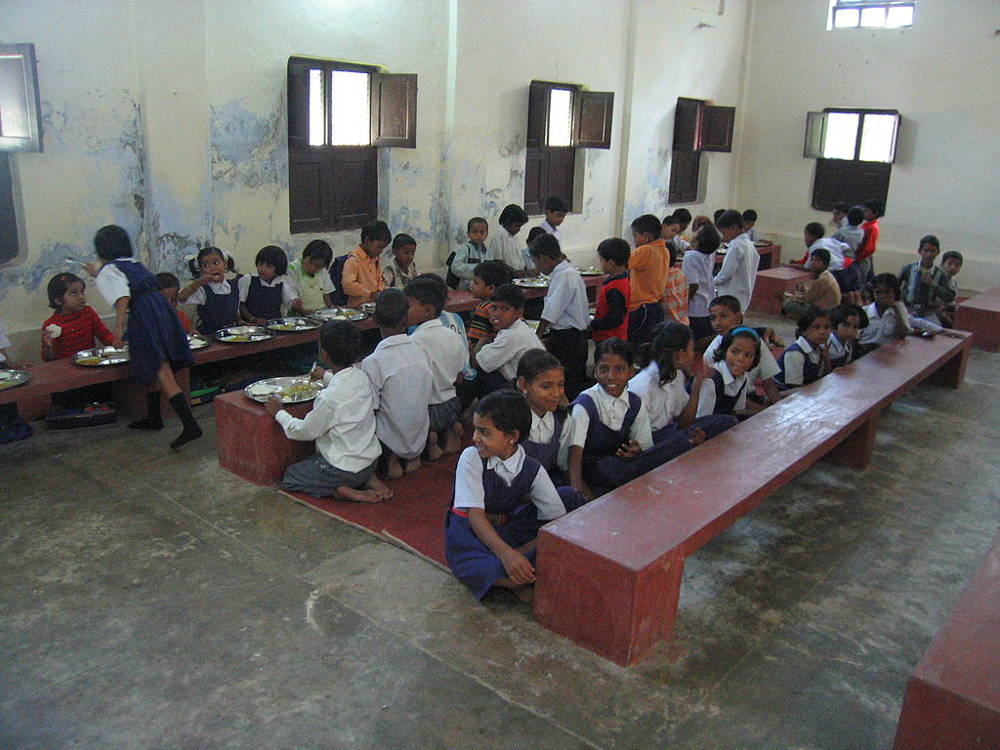[By Ajay Tallam from Milpitas, USA (IMG_2974) (CC BY-SA 2.0), via Wikimedia Commons]
The midday meal scheme, right from the time it was introduced, has proven to confer several blessings on society. Schoolchildren get much needed nutritious food. Class attendance goes up. It even creates social cohesion and harmony among kids. Few things help in bonding as much as a shared meal.
Late last month, the government announced that it wants the scheme—which now caters to over 100 million students in classes one to eight across the country—to be linked to Aadhaar. The move was seen as unnecessary meddling with an effective and popular scheme. Besides, food is an emotional issue, and it kicked up intense debate between the move’s critics and supporters.
The sound levels of the debate came down a few notches after HRD minister Prakash Javadekar assured that no child will be denied meals for not having an Aadhaar card. However, it is important to take a look at the debate because some of the key points raised will persist as more and more schemes use Aadhaar’s authentication feature. There are also some important lessons to take away from the discussions.
They fall under broadly four categories: the intent of the government, the process it followed, issues with execution, and the impact of the move.
Critics of the move argue that the intent of the government was merely to increase Aadhaar enrolment. By the last count, 1.12 billion Indians—or 88.2% of the population—have an Aadhaar number, and the government wants merely to push it up. Some others said the government had a bigger design. It wants to replace the existing system with a direct benefit transfer (DBT), and credit cash to parents’/guardians’ accounts. It wants to do away with the trouble of employing cooks making fresh food for children. It already does that with LPG. DBT, a favourite policy device of the right, never had much acceptance by the others, but in this particular case, they said, it would mean taking away the second order benefits of the midday meal scheme—school attendance, social cohesion, etc.
Its supporters, who come with the assumption that Aadhaar is fundamentally a good scheme, don’t see anything wrong in schoolchildren enrolling for Aadhaar. It gets them an identity early on in their lives—even before they get a driver’s license or a PAN card or a voter’s card. As for DBT, they point out that an Aadhaar-based system need not necessarily replace the existing system, but it promises to make it more efficient and reduce fraud. The public distribution system in Krishna district, Andhra Pradesh, is a case in point. Linking it with Aadhaar improved the system and has a large number of happy ration card holders to vouch for it.
Some critics raised a question about the government’s rationale and the method. They pointed out that the midday meal scheme is not a regular subsidy. Unlike other subsidies—LPG subsidies or railway discounts to senior citizens—midday meal is not given directly to the children, but to schools. To put it in the same category as the others is wrong. But more importantly, the Supreme Court has said in an interim order that Aadhaar shall be purely voluntary till the final hearing by the court. That hearing hasn’t taken place yet. So, the government in not right in rushing to link it with the midday meal scheme—which in fact makes Aadhaar mandatory for the scheme.
Its supporters are on a sticky wicket here. Both the present and earlier governments have failed to make the initiative pass through the full range of democratic checks and balances. Using the Money Bill to connect Aadhaar to PAN card is a recent example. To counter this its supporters take a utilitarian approach. They argue that the government had no other choice but to rush through its implementation, and that one shouldn’t let the opponents scuttle a good scheme through the regular democratic processes.
One criticism that resonates with many, especially after demonetisation, is about execution. Critics say the deadline for getting an Aadhaar number would be a burden on students, and biometric authentication itself—given the technology is not yet perfect—would only strain the system. Some studies indicate that it takes several attempts before a person is authenticated, and sometimes there is the problem of false negatives. All of this goes against the principle that no one should be denied the benefits.
Its supporters, however, say that this is a less complex problem, and unlike in demonetisation which came as a surprise even to key players, the enrolment process for Aadhaar is fairly well established. The authentication problem, they argue, is probably overblown, given that in the case of Reliance Jio, 92% of authentication happened in the first attempt. In any case, it would be good for the schools, the administrators, and the children to go through this learning curve as a stepping stone to the digital economy.
The big question is, of course, whether there will be enough benefits to the society at large.
Its critics argue Aadhaar will not solve any problem that the midday meal scheme faces. First of all, there is no evidence that there is overcounting (which can be solved by authentication). Instead, there are issues around quality of food, availability of food, and maintenance of kitchens—none of which would be solved by Aadhaar. Not only will it not solve these problems, it might cause harm. Economist Jean Dreze has pointed out that there are exclusion errors—even wilful exclusion errors, as with the case of an officer cancelling some job cards under the Mahatma Gandhi National Rural Employment Guarantee Scheme (MGNREGS) because he was under pressure to achieve 100% seeding.
Supporters insist that it would make the midday meal scheme better.
While the scheme is undoubtedly good, it is far from perfect. A 2015 report by the Comptroller and Auditor General (CAG) of India pointed out the institutional exaggeration of students availing midday meals, leakages and losses in the programme. Even in Tamil Nadu, which is often cited as a success story, there were cases where fine rice provided by the government was replaced with inferior rice. In some cases, these underlying problems have manifested as tragedies, as in the case of a primary school in Bihar where 23 children died after eating midday meals.
The benefits of efficiency, of running a clean ship, of a corruption-free system, are often underestimated. The cost savings can be used to expand the service to a larger set of beneficiaries. The number of students getting midday meals is about 20% less than the number of students enrolled in government schools. Besides, creating a corruption-free system will attract better people into the system, which in turn could kick off a virtuous cycle. For this, weeding out the ghost numbers could just be the beginning. A recent report said Aadhaar linkage exposed 4.4 lakh ghost accounts in just three states.
It’s not difficult to imagine similar debates playing out in almost every case of linking up Aadhaar. Take the news about linking Aadhaar to PAN cards. There are suspicions about the government’s intent. There are questions about the process it is following. There are concerns about execution. And there are debates about the impact. (Some of the most intense debates are in fact around privacy and security—which we will deal with in a forthcoming post.)
The lessons that emerge
There are three big lessons from the issues raised around midday meals so far.
Aadhaar is not a silver bullet: Aadhaar, by itself, cannot solve all problems. It is an authentication tool, and that’s pretty much what it basically does. But since identity is basic to many services, it plays an important role. It’s often necessary, but seldom sufficient. Aadhaar is just one piece of the puzzle; there are others that the government has to put together to solve issues. For example, in case of PDS in Krishna district, merely asking the ration card holders to authenticate themselves with Aadhaar would have had only a limited impact. The key was to let them use any PDS outlet they wished, instead of being stuck with the one they were assigned. They could then vote with their feet, and the system got better.
The government needs to get its messaging right: Government agencies often communicate as if it’s not meant for others. They hold back information, they obscure it with jargon. They don’t understand that their priorities may not be the priorities of the citizens they serve, and their assumptions about the world may not be shared by others. This was very evident in the case of midday meals—and the move was seen as heartless. It was probably never the intention of the government to consciously let students without an Aadhaar card go hungry, but it took it several days to communicate that.
Aadhaar will only work well when there are checks and balances: Whenever there is a change, it’s almost a given that some people—even those who were supposed to benefit from the change—will lose out. When there are reports that ghost accounts have been eliminated, how are we to really know that the numbers don’t include genuine accounts? The government must consciously create a process to ensure that this doesn’t happen. It’s a well-known fact that the bureaucratic system is good at feedback when the news is good, and it fails when there is bad news. It must strengthen the channels of communication from civil society. There will be slippages. The government will have to respond. The tendency of the critics is to dismiss the entire system because of some specific incidents. And the tendency of the supporters is to dismiss those instances, saying that they are exceptions. What we need is a way to quickly address such instances of failure.
Let me end with an anecdote: In the sixties, a chief minister, known for his efficiency, was touring the rural areas of his state. In one village, he saw a boy herding cows in the middle of the day. He asked the boy why he was not in school. The kid, in a typical rustic fashion, shot back, “Who will give me food if I go to school? Will you?” The question deeply impacted the minister, and he resolved that his government would introduce a noon meal programme for schoolchildren. That state was Tamil Nadu, and the politician was K Kamaraj. In doing so, Kamaraj displayed a keen instinct for combining empathy with his efficiency. That’s very much needed today.




Ramnath Subbaraman on Apr 04, 2017 2:37 a.m. said
With reference to Balaji's comments, the reason why UPA invested so much in the project was that Aadhaar could potentially make government services more efficient - reform the broken (and often corrupt) subsidy system, and improve government-citizen transactions. Many believed that Aadhaar will not become a reality - that it will get sucked into cost/time overruns like some other government projects did - and didn't really pay attention to this bigger goal (i.e, making government services more effective by linking it to Aadhaar). But, all these were pretty clear for those who followed Aadhaar on newspapers/ television channels. So, while the Tamil adage is interesting, and even evocative (thanks for sharing that), it doesn't apply here at all.
Last para again gets it wrong, because of faulty assumption/terminology. If your purpose is to make something efficient, there is always a risk of cutting the muscle instead of fat, there is a risk of ignoring second order impacts, there is a risk of overreach, there is a risk of unintended consequences. You need strong checks and balances, because that will give the much needed feedback so the system can correct itself and serve its purpose.
Balaji on Apr 03, 2017 6:29 a.m. said
An old Tamil adage goes like this - "An unemployed barber ends up tonsuring the cat." In case of Aadhar, it's even worse - The manufacturer of a blade forced a person to become a barber, who could not find any clients and ended up tonsuring the cat. Mr. Nandan had a fine idea called an Unique ID card; He did not know how to use it and importantly, where to use it. Being an excellent salesman, he got the Government to set up a institution outside the scope of legislature and executive and executed the Aadhar. Now, the Government who is akin to the barber in my example could not find any meaningful utility out of the tool and starts forcing it through every schemes. That sums the existence of Aadhar for me!
Before implementing Aadhar in the mid-day meal scheme (MDMS), the Government must have spelled the objectives clear. As the author rightly points out, there has been instance of pilferage and even tragic circumstances, like death of children due to contaminated food. Can Aadhar help in solving either of the two problems? If so, how? During a conversation with the school children in Government School, their major gripe was teachers pilfering eggs allotted for MDMS.
Replacing MDMS with DBT? That defeats the objective of the whole scheme. Will the parents ensure that the DBT is used for feeding the children? If they fail to do so, can the Government take any action on them?
MDMS, as such, needs to be decentralised more. The meals provided for someone in Chennai need not be same for someone in Ooty or Salem. By introducing Aadhar, it only makes a move towards centralising the initiative.
By saying that Aadhar will only work when there are checks and balances, the author seems to concede that there is no point of Aadhar, for it was brought in as a tool for checks and balances.